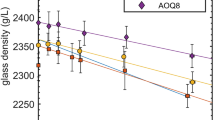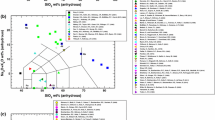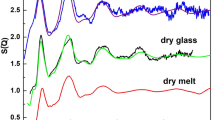Abstract
Structural similarities between dry diopside melt and superhydrous albite melt (X w >0.5) — both lack three-dimensional silicate units — suggest that thermodynamic relations may be similar. A model based on that assumption successfully predicts diopside melting relations and H2O solubilities. For the model, the three partial differential equations describing solution of H2O in albite melt for X w >0.5 have been integrated for diopside melt from X w =0 to X w at least as large as 0.76, with two exceptions: an alternative partial differential equation for Henrian solution of H2O in dilute melts was applied for X w <0.20, and an alternative differential equation for the pressure dependence of a w at pressures below 2 kbar was developed. The latter alternative equation yields relatively small ¯Vw's at low pressures rather than the large ¯Vw's calculated from the equation from the albite system. Available experimental solubility data are not precise enough to offer a choice between the small-¯Vw and large-¯Vw equations. Integration of all the partial differential equations was constrained solely by the P and T of a single experimentally-determined point on the H2O-saturated solidus.
Solubilities calculated by a Henrian-analogue solution model (a di=X 2di ) from the experimental H2O saturated solidus lie outside experimental solubility constraints for dilute melts. On the other hand, a Henrian model (a di=Xdi) successfully predicts solubilities in dilute melts. The formulation of the Henrian model and magnitudes of model molar entropies of solution are consistent with the hypothesis that H2O dissolves in diopside melt as an essentially undissociated species with little ordering on melt structural sites. That species could in turn be consistently, if not uniquely, interpreted to be molecular H2O or a hydroxylation (OH−) complex formed from nonbridging oxygens.
Similar content being viewed by others
References
Birch F (1966) Compressibility; elastic constants. In: SP Clark Jr (ed) Handbook of Physical Constants. Geol Soc Am, New York, pp 97–174
Burnham CW, Davis NF (1971) The role of H2O in silicate melts. I. P-V-T relations in the system NaAlSi3O8 -H2O to 10 kilobars and 1,000° C. Am J Sci 270:54–79
Burnham CW, Davis NF (1974) The role of H2O in silicate melts. II. Thermodynamic and phase relations in the system NaAlSi3O8-H2O to 10 kilobars, 700°C–1,100°C. Am J Sci 274:869–881
Eggler DH, Rosenhauer M (1978) Carbon dioxide in silicate melts: II. Solubilities of CO2 and H2O in CaMgSi2O6 (diopside) liquids and vapors at pressures to 40 kb. Am J Sci 278:64–94
Hodges FN (1974) The solubility of H2O in silicate melts. Carnegie Inst Wash Yearb 73:251–255
Holloway JR (1981) Volatile interactions in magmas. Adv Phys Geochem 1:273–293
Mysen BO, Virgo D, Harrison WJ, Scarfe CM (1980) Solubility mechanisms of H2O in silicate melts at high pressures and temperatures: a Raman spectroscopic.study. Am Mineral 65:900–914
Mysen BO, Virgo D, Seifert FA (1982) The structure of silicate melts: implications for chemical and physical properties of natural magma. Rev Geophys Space Phys 20:353–383
Navrotsky A, Capobianco C, Stebbins J (1982) Some thermodynamic and experimental constraints on the melting of albite at atmospheric and high pressure. J Geol 90:679–698
Skinner BJ (1966) Thermal expansion. In: SP Clark Jr (ed) Handbook of Physical Constants. Geol Soc Am, New York, pp 75–96
Stebbins JF, Carmichael ISE, Weill DF (1981) Heats fusion of diopside and sanidine and high pressure volume changes in aluminous silicate liquids. Geol Soc Am Abstr Progr 13:560
Stolper E (1982) Water in silicate glasses: an infrared spectroscopic study. Contrib Mineral Petrol 81:1–17
Uys JM, King TB (1963) The effect of basicity on the solubility of water in silicate melts. Metall Soc AIME Trans 227:492–500
Yoder HS Jr (1954) The system diopside-anorthite-water. Carnegie Inst Wash Yearb 53:106–107
Yoder HS Jr (1965) Diopside-anorthite-water at 5 and 10 kilobars and its bearing on explosive volcanism. Carnegie Inst Wash Yearb 64:82–89
Author information
Authors and Affiliations
Rights and permissions
About this article
Cite this article
Eggler, D.H., Burnham, C.W. Solution of H2O in diopside melts: a thermodynamic model. Contr. Mineral. and Petrol. 85, 58–66 (1984). https://doi.org/10.1007/BF00380221
Received:
Accepted:
Issue Date:
DOI: https://doi.org/10.1007/BF00380221




